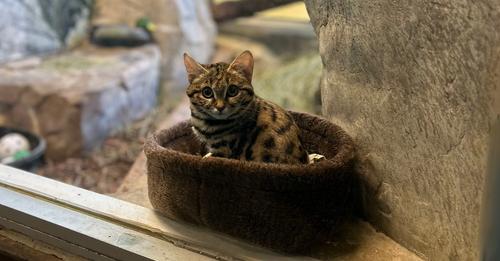:focal(1506x760:1507x761)/https://tf-cmsv2-smithsonianmag-media.s3.amazonaws.com/filer_public/43/f0/43f0ac0e-5e65-4b04-ad6f-074c50157ad4/img_7672.jpeg)
Utah’s Hogle Zoo
Big cats like tigers and lions have earned a reputation for being some of the fiercest predators on the planet. But bigger doesn’t always mean better in the animal kingdom—just ask Gaia, the 8-month-old black-footed cat who recently arrived at Utah’s Hogle Zoo.
Though she may look cute, Gaia is a top-notch hunter. In the wild, black-footed cats successfully catch their prey 60 percent of the time—earning them the title of the “world’s deadliest cat.” The animals eat between eight and 14 meals every evening, and just one of the felines can devour upwards of 3,000 rodents per year. (For comparison, big cats have a hunting success rate of around 25 percent, reports the Salt Lake Tribune’s Jordan Miller.)
But black-footed cats are in trouble—and that’s where Gaia comes in. She’s part of a North American breeding program organized by the Association of Zoos and Aquariums that aims to help the cats’ numbers rebound. Zookeepers brought Gaia to Hogle Zoo, because they hope she will one day mate with a 3-year-old male at the facility named Ryder.
“We laugh and joke about it as being endangered species dating,” says Bob Cisneros, Hogle Zoo’s associate director of animal care, to the Salt Lake Tribune.
View this post on Instagram
The International Union for Conservation of Nature (IUCN) lists black-footed cats as “vulnerable.” Scientists estimate roughly 9,700 mature individuals live in the savannas, grasslands and deserts of Botswana, Namibia and South Africa. Their numbers are decreasing because of human development, livestock farming, hunting, trapping, disease and habitat changes, per the IUCN.
Black-footed cats are smaller than a typical house cat, weighing between 2 and 6 pounds on average. Even so, they’re some of the most exacting killers on the planet. They hunt at night, using their stellar vision and quick speed to pounce on birds, reptiles, insects and rodents. In captivity, Gaia is eating special food made of organs, skeletal muscle and ground bone, plus a few humanely euthanized mice, reports the Salt Lake Tribune.
/https://tf-cmsv2-smithsonianmag-media.s3.amazonaws.com/filer_public/a0/ed/a0ed4665-9edd-42fe-bb9a-96669233ccad/img_7674.jpeg)
Utah’s Hogle Zoo
Gaia was one of four kittens born at the Fossil Rim Wildlife Center in Texas last year. She’s genetically different enough from Ryder that zookeepers thought the two would make a good breeding pair, so they sent her to Utah in October. They’re being kept apart for now, but once Gaia reaches sexual maturity, zookeepers will put them together and see if sparks fly. That could happen as early as this fall.
Last week, staff at Hogle Zoo put Gaia on display in the small animals exhibit, giving the public their first opportunity to see her. So far, the 2.64-pound kitty is still getting comfortable in her new environment. And, like other members of her species, Gaia is nocturnal, so she’s the most active at night, when the zoo is closed.
But, over time, zookeepers hope she’ll serve as an ambassador for her species and for wildlife conservation efforts more broadly.
“While animals like Ryder and Gaia may be found in Africa, far away from what we do on a daily basis… they become representatives of a conservation message that applies to everything here,” says Cisneros to the Washington Post’s Justine McDaniel.
